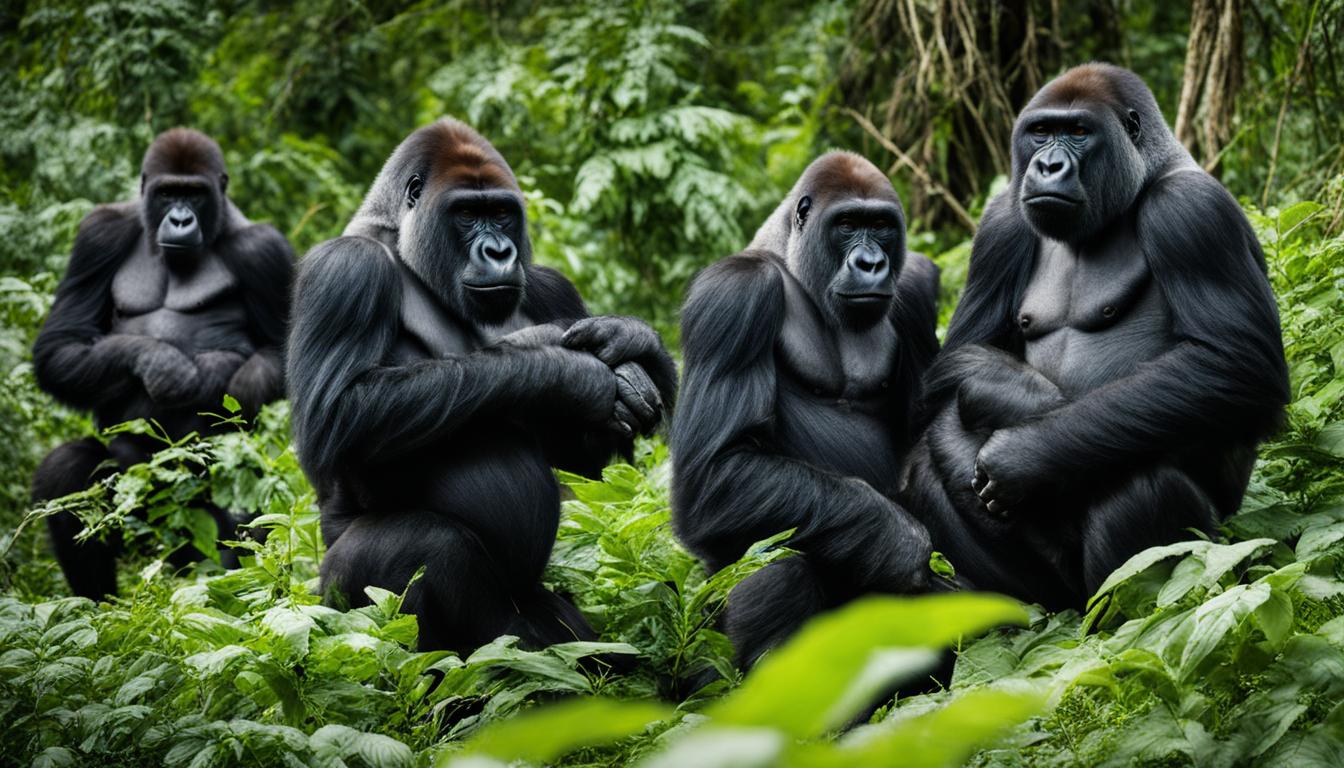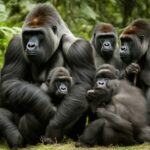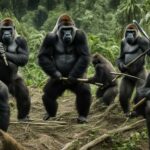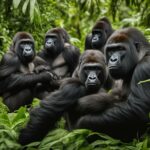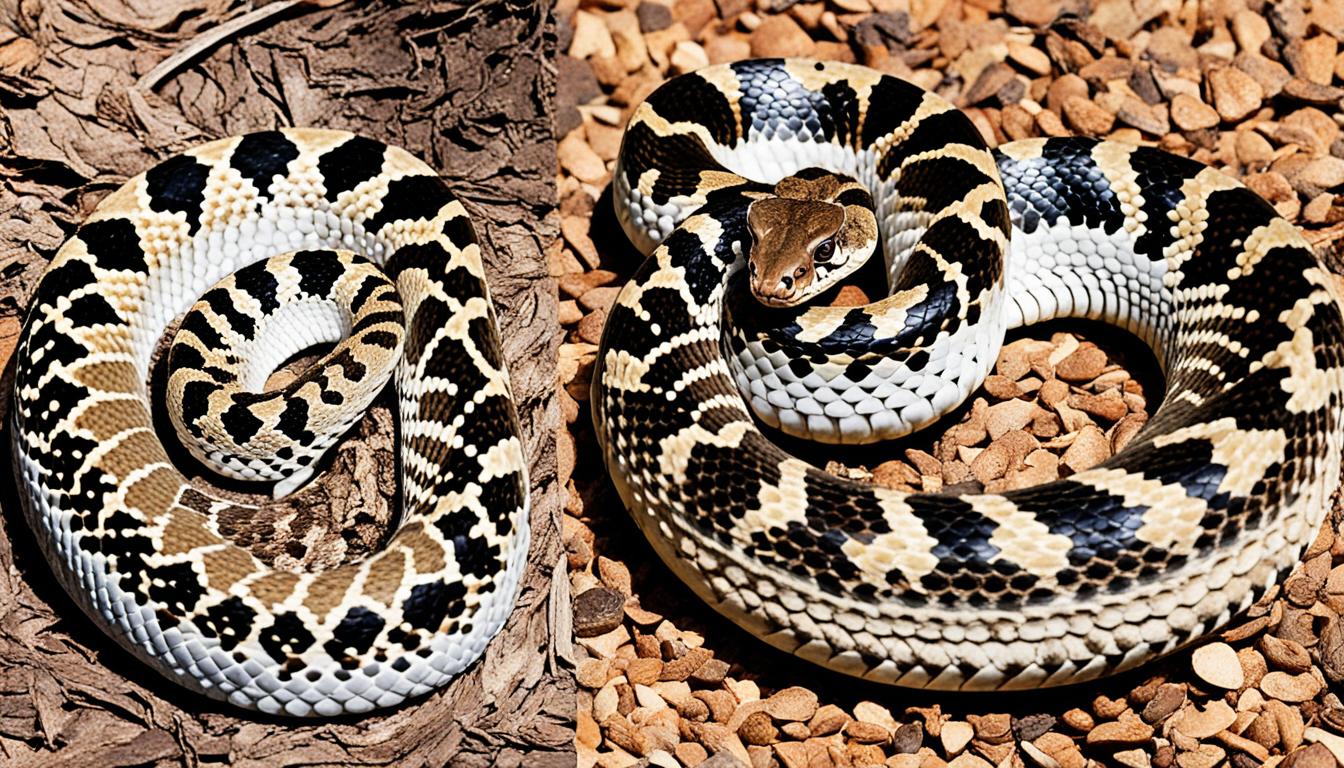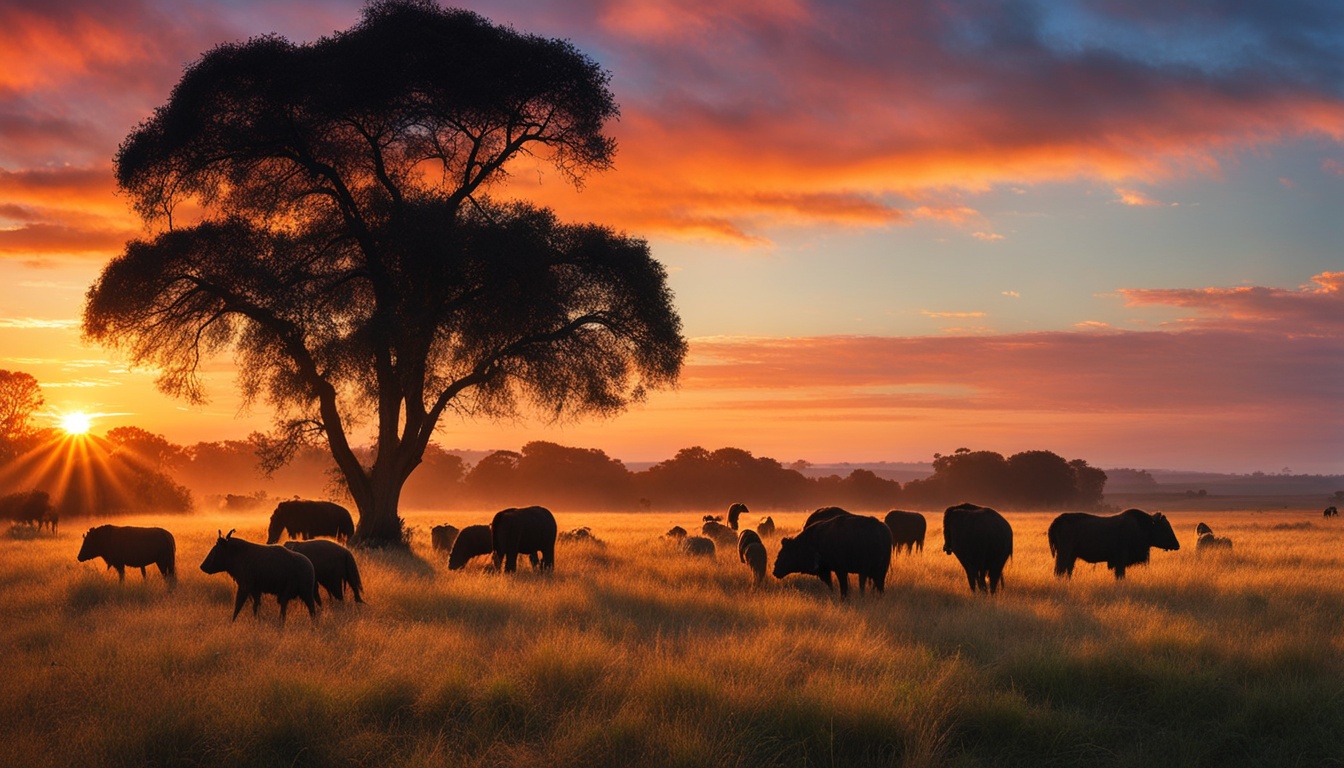Gorilla disease threats, gorilla conservation, and primate health are crucial topics that require attention and action. Gorillas, like humans, are susceptible to various infectious diseases, including the recent SARS-CoV-2 pandemic. The presence of dense human populations near gorilla habitats increases the risk of disease transmission, making it essential to address these threats.
Respiratory diseases, such as bronchopneumonia, can be particularly fatal for gorillas. To combat severe respiratory infections, the Gorilla Doctors provide medical intervention, including antibiotics and physical exams. However, physical injuries caused by snares and gorilla-inflicted trauma are also major health threats that demand attention.
Stay tuned as we explore in detail the infectious diseases, snares, gorilla-inflicted trauma, habitat degradation, hunting and poaching, bushmeat, traditional medicine, and the importance of conservation efforts in ensuring the survival of wild gorillas and the overall health of primate populations.
Infectious Diseases
Gorillas, being genetically similar to humans, are vulnerable to various infectious diseases, including viral infections. One of the most significant infectious disease threats to gorillas is the recent emergence of SARS-CoV-2, the virus responsible for the COVID-19 pandemic. Due to their close proximity to dense human populations, gorillas are at an increased risk of contracting the virus from humans. Respiratory diseases, such as bronchopneumonia, can be particularly dangerous for gorillas, often leading to severe illness and mortality.
https://www.youtube.com/watch?v=kc4EDmdePQ4
Respiratory diseases are a common threat to gorillas, and monitoring for symptoms is an essential part of their healthcare. The identification of the precise cause of a disease allows for informed medical decisions and targeted treatment strategies.
Efforts to combat infectious diseases in gorillas involve close monitoring of gorilla populations and the development of medical interventions. The Gorilla Doctors, a dedicated team of veterinarians, administer antibiotics to treat bacterial infections and provide physical exams to diagnose and monitor respiratory ailments. The ongoing research and monitoring efforts contribute valuable insights into gorilla health and aid in the conservation of these primates.
Gorillas and zoonotic diseases
The threat of infectious diseases in gorillas extends beyond their own health. Gorillas can serve as a reservoir for zoonotic diseases, which are infections that can spread from animals to humans. Understanding the transmission dynamics of these diseases is crucial in preventing outbreaks among both gorilla populations and neighboring human communities. By studying infectious diseases in primates like gorillas, researchers can gain valuable insights into the broader field of wildlife health and contribute to the global understanding of zoonotic diseases.
Gorilla Population Decline and Habitat Destruction
Gorillas face numerous threats that contribute to their population decline and the destruction of their natural habitat. One major threat comes in the form of snares set by poachers. These snares, made of ropes and wires, are intended to catch animals for bushmeat but often result in accidental capture and injury of gorillas. This poses a significant risk to their survival, as these injuries can lead to amputations, infections, and even death.
The Gorilla Doctors, a dedicated team of veterinarians, play a crucial role in addressing this threat. When an ensnared gorilla is identified, the Gorilla Doctors evaluate the situation and safely dart the gorilla to provide necessary medical care. It is important to note that all veterinary interventions are carried out in the forest, without removing gorillas from their natural habitat.
| Snares | Impact |
|---|---|
| Injuries | Amputations, infections, and death |
| Intervention | Gorilla Doctors provide necessary medical care |
Another significant threat to gorilla populations is habitat degradation. Mining, logging, agriculture, and road building activities result in the rapid destruction of gorilla habitats. This leads to habitat fragmentation, inbreeding, and increased vulnerability to diseases. Commercial logging and the development of new transport infrastructure also facilitate poaching by providing access to previously inaccessible forest areas.
Conservation efforts work towards preserving gorilla habitats and combating the bushmeat trade. By addressing these threats, we can help protect gorillas and ensure the survival of these magnificent primates for future generations.
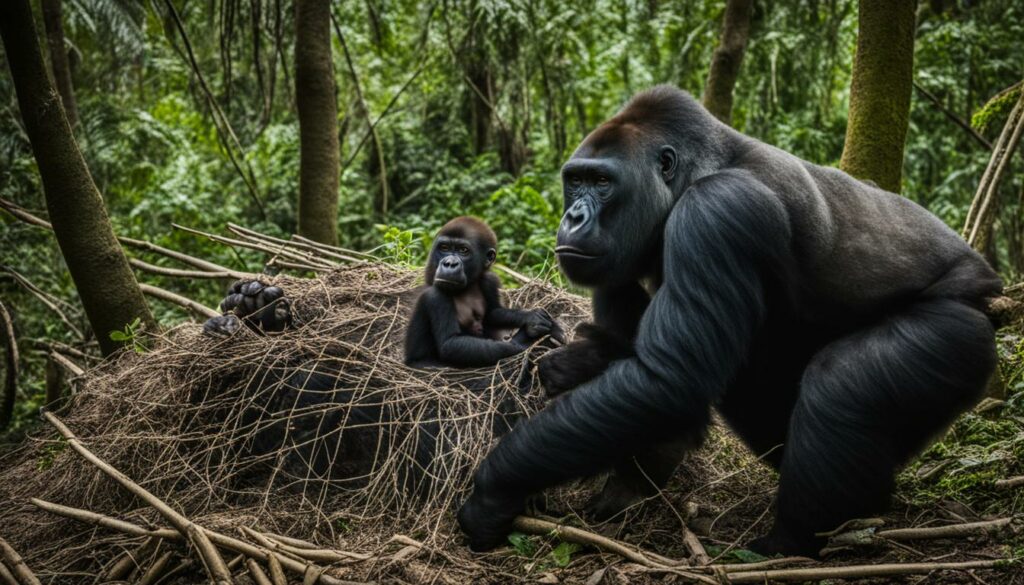
Gorilla-Inflicted Trauma
Physical injuries caused by gorillas themselves are a leading cause of death among mountain gorillas. Gorillas, like any wild animal, can be aggressive and engage in behaviors that result in trauma and injury. Infanticide, which occurs when a dominant male kills an infant gorilla, is one example of gorilla-inflicted trauma. Fights between silverbacks, the dominant males in gorilla groups, can also lead to severe injuries that can be fatal.
In addition to intentional harm, gorillas can accidentally injure each other, especially during social interactions. Females and young gorillas are particularly vulnerable to accidental injuries. These injuries can range from minor cuts and bruises to more severe wounds that require medical intervention.
The Gorilla Doctors, a team of dedicated veterinarians and conservationists, sometimes intervene to save individuals with life-threatening injuries caused by gorillas. Their interventions aim to preserve genetic diversity and ensure the survival of injured gorillas. As the population of mountain gorillas grows, the need for intervention may decrease, but gorilla-inflicted trauma remains a significant threat to primate health and population decline.
Gorilla Habitat Degradation
Gorilla habitat degradation is a pressing concern for wildlife conservation efforts and the survival of gorilla populations. Human activities such as mining, logging, agriculture, and road building are rapidly transforming gorilla habitats, leading to fragmentation and increased vulnerability to diseases. Commercial logging and the construction of new transport infrastructure also facilitate poaching by providing easier access to previously inaccessible forest areas.
The impact of habitat degradation on gorillas is significant. It not only disrupts their natural behavior and reduces their access to food and resources but also increases their exposure to potential threats. As gorilla habitats diminish, the risk of inbreeding increases, resulting in reduced genetic diversity, weaker immune systems, and diminished overall population health.
The illegal bushmeat trade is closely linked to habitat degradation, as it drives the demand for wild animal products, including gorilla meat. The trade contributes to the loss of gorilla populations and poses a direct threat to their survival. Addressing habitat degradation requires a holistic approach that combines efforts to conserve gorilla habitats, reduce the demand for bushmeat, and enforce laws to combat illegal activities.
| Habitat Threat | Impact |
|---|---|
| Mining | Destruction of vegetation, contamination of water sources |
| Logging | Habitat loss, fragmentation, reduced food availability |
| Agriculture | Deforestation, reduced habitat quality |
| Road building | Increased accessibility for poachers, habitat fragmentation |
“The rapid degradation of gorilla habitats poses a severe threat to their survival and the delicate balance of ecosystems they inhabit.” – Dr. Jane Goodall
Gorilla Population Decline and Wildlife Conservation Efforts
Gorilla populations are facing a severe decline due to hunting and poaching activities. These illegal practices, driven by the demand for bushmeat and the trade of gorilla body parts, have had a devastating impact on wild gorilla populations. Even low levels of poaching can cause a significant decline in numbers. To combat this threat, effective enforcement of laws and better governance are crucial.
“Poaching for bushmeat and the illegal trade of gorilla body parts pose a major threat to wild gorilla populations.”
Conservation efforts must focus on reducing the demand for bushmeat and promoting sustainable alternatives to protect gorillas.
Gorillas are also unintentionally caught in traps set for other animals, further contributing to their decline. This accidental capture and injury pose additional risks to already vulnerable populations. Strong efforts must be made to address these issues and prevent innocent gorillas from falling victim to indiscriminate trapping methods.
Impact of Gorilla Population Decline
The decline in gorilla populations has far-reaching consequences for wildlife conservation efforts. Gorillas play a vital role in maintaining the balance of their forest ecosystems. As key influencers in seed dispersal and vegetation management, their absence can disrupt the natural dynamics of the environment.
“Conservation efforts must focus on reducing the demand for bushmeat and promoting sustainable alternatives to protect gorillas.”
- Gorillas contribute to seed dispersal, aiding the regeneration of plant species.
- Their browsing behavior helps maintain vegetation structure and diversity.
- By creating clearings in the forest, gorillas create opportunities for other species to thrive.
Preserving gorilla populations is not only crucial for the survival of these magnificent primates but also essential for maintaining healthy and balanced ecosystems that support a wide range of biodiversity. It requires collaborative efforts from governments, conservation organizations, and local communities to combat hunting and poaching activities, reduce the demand for bushmeat, and protect the habitats of these endangered creatures.
Bushmeat and Traditional Medicine
The commercial trade in bushmeat, especially ape meat, poses the biggest threat to gorillas. Gorillas are hunted and killed for their meat, which is considered a delicacy, as well as for traditional medicine and as magical charms. The demand for ape meat in urban centers drives the illegal bushmeat trade, perpetuating this threat to gorilla populations. Not only does the bushmeat trade directly impact gorillas, but it also contributes to the spread of wildlife diseases, including zoonotic diseases that can be transmitted to humans.
The consumption of bushmeat has been linked to the transmission of diseases such as Ebola, HIV, and other infectious pathogens. Zoonotic diseases have the potential to cause devastating outbreaks in humans, as we have witnessed with the COVID-19 pandemic. The close genetic similarity between humans and gorillas makes them highly susceptible to these diseases, further highlighting the need to address the bushmeat trade and its associated health risks.
Conservation efforts are focused on reducing the demand for bushmeat and promoting sustainable alternatives. Education and awareness campaigns are crucial in informing the public about the environmental and health consequences of the bushmeat trade. By advocating for responsible consumption and supporting local communities in finding alternative sources of income, we can help mitigate the threat posed by the commercial trade in bushmeat. Additionally, strict law enforcement and international cooperation are vital for combating the illegal wildlife trade and protecting endangered species like gorillas.
“The bushmeat trade not only decimates wildlife populations but also poses a significant risk to global health. We must prioritize the conservation of gorillas and other endangered species to safeguard both the natural world and human well-being.”
The Impacts of the Bushmeat Trade:
The bushmeat trade has far-reaching consequences, affecting wildlife, ecosystems, and human health. Here are some key impacts of the bushmeat trade:
- Loss of biodiversity: Overhunting for bushmeat disrupts the delicate balance of ecosystems, leading to the decline of numerous wildlife species.
- Habitat destruction: The demand for bushmeat drives deforestation, as hunters often resort to slash-and-burn techniques to access wildlife habitats.
- Species extinction: Many species targeted for bushmeat, including gorillas, are already critically endangered. Continued hunting could push them to the brink of extinction.
- Economic loss: The illegal bushmeat trade deprives communities of potential income from sustainable ecotourism, which can have long-term economic benefits.
| Impacts of the Bushmeat Trade | Consequences |
|---|---|
| Loss of biodiversity | Disruption of ecosystems and potential extinction of wildlife species |
| Habitat destruction | Deforestation and degradation of wildlife habitats |
| Species extinction | Further endangerment of already critically endangered species |
| Economic loss | Missed opportunities for sustainable ecotourism and local economic development |
Addressing the bushmeat trade is essential for the protection of gorillas, the preservation of ecosystems, and the prevention of zoonotic disease outbreaks. By supporting conservation efforts, advocating for responsible consumption, and promoting sustainable livelihoods for local communities, we can work towards a future where both wildlife and humans thrive in harmony.
Conclusion
Gorilla disease threats, such as infectious diseases, snares, and gorilla-inflicted trauma, pose significant risks to the survival of wild gorilla populations. These magnificent primates are susceptible to respiratory diseases, including the recent threat of SARS-CoV-2. Human encroachment on their habitats increases the risk of disease transmission. The Gorilla Doctors play a crucial role in providing medical intervention to treat severe infections and physical injuries, ensuring the well-being of these primates.
In addition to diseases, habitat degradation, hunting, and poaching further contribute to the decline of gorilla populations. The rapid destruction of gorilla habitats, driven by activities such as logging, mining, and agriculture, leads to fragmentation and increased vulnerability to disease. The illegal bushmeat trade, fueled by the demand for ape meat, perpetuates the threat to gorillas and other wildlife.
Effective wildlife conservation efforts involve monitoring gorilla health, implementing medical interventions, preserving their habitats, and addressing the illegal bushmeat trade. By joining these efforts, we can make a difference in protecting gorillas and ensuring the overall health of primate populations. Safeguarding the future of these magnificent creatures is not only important for their own survival but also for the preservation of our natural heritage.
How have Human Interactions Contributed to the Spread of Diseases Among Wild Gorilla Populations?
Human interactions have had a significant impact on gorillas, contributing to the spread of diseases among wild populations. Deforestation, habitat destruction, and illegal hunting have brought humans and gorillas closer, leading to the transfer of pathogens and causing devastating effects on their health and survival. The impact of humans on gorillas cannot be underestimated.
FAQ
What diseases pose a threat to wild gorilla populations?
Gorillas are susceptible to many infectious diseases that affect humans, including SARS-CoV-2. Respiratory diseases, such as bronchopneumonia, can be fatal for gorillas.
How are infectious diseases addressed in gorillas?
The Gorilla Doctors provide medical intervention, including antibiotics and physical exams, to treat severe respiratory infections in gorillas. Monitoring and research efforts contribute to gorilla health conservation.
What are snares and why do they pose a threat to gorillas?
Snares are rope and wire traps set by poachers to catch animals for bushmeat. Gorillas can become accidentally ensnared, leading to amputations, infections, or death.
How do the Gorilla Doctors intervene in the case of snares?
The Gorilla Doctors evaluate the situation and safely dart the ensnared gorilla. All veterinary care is delivered in the forest without removing gorillas from the wild.
What is gorilla-inflicted trauma?
Physical injuries caused by fights between gorillas, infanticide, and accidental injuries to females and young gorillas are considered gorilla-inflicted trauma. It is a leading cause of death among mountain gorillas.
When do the Gorilla Doctors intervene for gorilla-inflicted trauma?
The Gorilla Doctors may intervene to save individuals with life-threatening injuries to preserve genetic diversity, especially as the population grows.
How does habitat degradation affect gorilla populations?
The rapid degradation of gorilla habitats due to mining, logging, agriculture, and road building leads to fragmentation, inbreeding, and increased vulnerability to disease. Conservation efforts focus on preserving gorilla habitats and combating the bushmeat trade.
What are the threats posed by hunting and poaching?
Poaching for bushmeat and the illegal trade of gorilla body parts cause population decline. Even low levels of poaching can have a significant impact on gorilla populations.
How does the bushmeat trade contribute to gorilla threats?
The commercial trade in bushmeat, including ape meat, is the biggest threat to gorillas. It leads to wildlife diseases, including zoonotic diseases that can spread to humans. Conservation efforts aim to reduce the demand for bushmeat and promote sustainable alternatives.
Why is gorilla conservation important?
Gorilla disease threats, habitat degradation, hunting, and poaching pose significant risks to wild gorilla populations. Protecting gorillas and their habitats is crucial for their survival and the overall health of primate populations.

